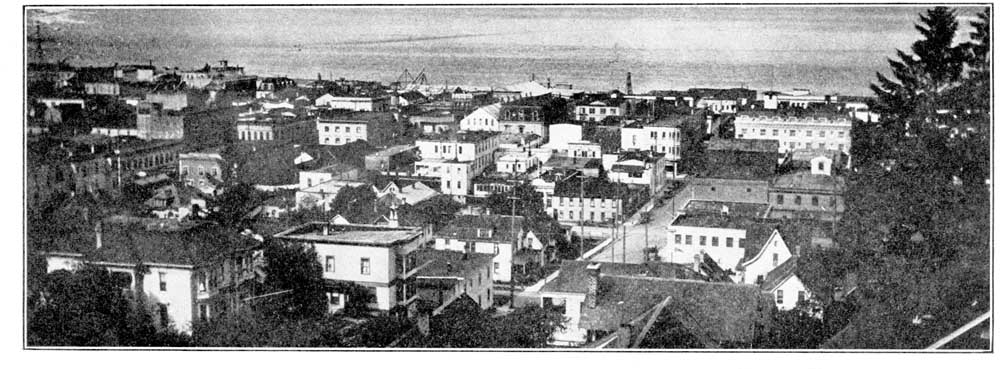Well Preserved: 12th & Grand Avenue Rentals Astoria, Oregon
Published 4:23 am Sunday, January 8, 2017

- A 1920 photo captures the Fisher brothers' two residences (lower left hand corner).
ASTORIA — Kris Haefker visited Astoria as a child with his father, Uwe. A German immigrant and professional opera singer in Portland, Uwe was also a window dresser for Butch’s For Sir, a mens clothing store in downtown Astoria. During these trips, Kris became familiar with Astoria and its wealth of historic structures. Now a professional building contractor, Kris has returned to Astoria. “My goal has always been to fix up derelict buildings, add to the housing inventory and enhance the street,” he said.
Haefker started with the Abraham and Lottie Jaloff residence at 1149 Grand Avenue. Abraham and his brother Jacob are said to have provided Astoria’s first taxi service. His wife Lottie, a milliner, produced hats for prostitutes in Astoria’s Red Light District.
When Haefker arrived, the 1916 house was scattered with “animal remnants” and carpenter ants. “If I had to do it again… no way,” recalled Haefker. He hadn’t considered just how many stairs there were to reach the house. Access was a problem and erecting scaffolding a challenge. “I fixed (the house) with a thin budget and hard work,” he said.
Later, when life in and around Portland became too expensive, Haefker looked to Astoria for a full-time home for his family. He acquired the Ferdinand and Augustus Fisher residence, at 687 12th Street. The Fishers were brothers and owners of a chandlery, hardware and grocery store. Augustus was single and lived in the house with his brother Ferdinand and sister-in-law Clara. Today, Haefker is revitalizing structures on either side of this circa 1890 property.
The View Apartments, at 665 12th Street, stand north of his house. The structure was constructed by the Fisher brothers in 1911. Unbelievably, they moved from their magnificent Italianate house, converted it to a boarding house, and lived in this more common looking structure. After they died, their new home was converted into five apartments.
When Haefker began the structure’s renovation, he wondered to himself, “What in the world did you get yourself into?” It needed a new roof, new plumbing and immediate rot repair. “It was overwhelming,” he said. But bit by bit, he is upgrading each apartment: cleaning, painting, re-exposing wood floors and recycling materials when he can.
About the time he acquired the Fisher house, a triplex just west of it went up for sale. The triplex, at 1156 Grand Avenue, is a jumble of a structure. “I swore there was no way…I never wanted to own it,” Haefker remembered. “Then I had a car accident, got a bump on the head and had two months of recovery. On my first drive back from Portland, I was still in shell shock….” He bought the triplex.
The triplex is one of Astoria’s most curious buildings. In the early 1920s, three houses from Chinatown were pulled up the hill and shoved together as one. The construction dates of the structures are unknown, but an intact side window may date to the 1860s. Its earliest known occupants were Joseph and Catherine Gribler. In the 1870s, Joseph was known for composing music for “famous” black-faced comedians. In 1913, he was charged with “operating a house of ill-fame.”
Haefker said the building’s unique history was part of his motivation to acquire it. He immediately replaced rot, using locally sourced materials. Most noticeably, he replaced worn wood shingles from the front facade and replaced them with historically proportioned, Hardie Board, cement-fiber siding. He also replaced an aluminum window with a salvaged, period, wood window. Appropriate casings were rebuilt for all front windows.
Then, 1142 Grand Avenue caught his eye. The long-abandoned house was on the City’s list of derelict buildings. Anders and Anna Bergman were the home’s first residents in 1904. Anders was a house painter. A couple of carpenters, Axel and Frank Johanson, boarded with them. By 1913, the house was converted to a duplex. Albert Rose, a county roadmaster, and his wife Ella lived in the second apartment.
“I didn’t want the project,” said Haefker. “There were raccoons and other critters living in there….There were daunting tasks.” No interior space was habitable. Ivy reached the roof and breached two walls. The foundation was inadequate. He gutted the building, placed a new beam beneath it, used bleach and TSP everywhere, and retained or re-used woodwork wherever possible. He was fortunate to find a stash of wood windows in the house, ready to use.
Haefker believes Astoria’s housing crisis can — in large part — be solved through existing structures. “I’m taking derelict buildings and bringing them back online… near downtown where housing is needed most.” As Haefker returns multiple rentals back into the market, he is inspired by those who created them many years ago, “They just decided to roll up their sleeves and make it happen.”
For more information about renovating an old home or commercial building, visit the Lower Columbia Preservation Society website at lcpsociety.com.





